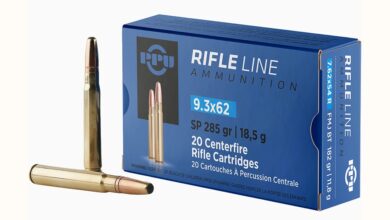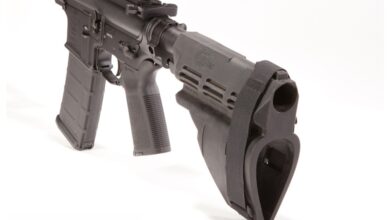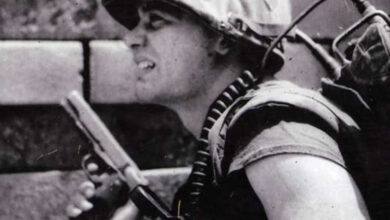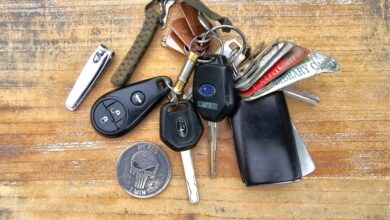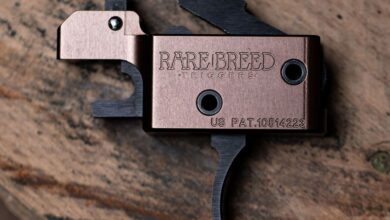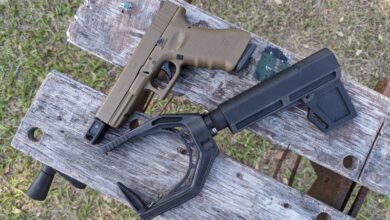The Iconic Peacemaker Rides Again in 38 WCF!
This year marks the 150th anniversary of the famed Colt Single Action Army (SAA) revolver. When it was introduced, the only chambering was .45 Colt, a cartridge specified by the military. That same year, Winchester announced its Model 1873 lever-action rifle in .44 WCF or .44-40. This slightly bottle-necked cartridge used centerfire priming, a brass case, and was more powerful than the .44 Henry Rimfire used in the Model 1866. Later in 1877, Colt produced its Frontier Six-Shooter, a SAA revolver chambered for the .44 WCF cartridge.
Testing the Cimarron Model P in 38 WCF
Now the frontiersman could carry a rifle and handgun that used the same cartridge. In 1879, Winchester decided to neck down the .44-40 cartridge case, enabling it to accept a .401-inch bullet as opposed to the .427-inch bullet used in the .44 WCF. Bullet weight was reduced from 212 to 180 grains, with the same 40-grain black powder charge. Users claimed this new cartridge “shot harder.” For marketing purposes, I suppose, Winchester decided to call this new cartridge the .38 WCF or .38-40.
A New Combination Cartridge
It appears that Colt again followed Winchester and in 1884 chambered the SAA sixgun in .38 WCF. Out of a 24-inch rifle barrel, the standard 180-grain loading produced around 1,150 fps. Depending on the barrel length out of a Colt revolver it might get 800-850 fps. With a bullet some 32 grains lighter, the felt recoil of the .38-40 was certainly less than the .44-40. Back in the day, ammunition manufacturers often offered loads that required users to read the recommendations on the cartridge box.
In my research, I’ve read where the .38-40 could be had with bullet weights as high as 217 grains. There was even a special rifle-only round that pushed a 180-grain JSP bullet to 1,775 fps. That could be murder on a 1st Generation Colt SAA! Winchester wasn’t the only maker of rifles in .38-40. Marlin first chambered a lever-gun in this caliber in 1888 and there were Colt and Remington slide-action rifles for this cartridge.
Winchester went on to make its Model 1892 lever-action in .38-40, and Colt chambered the Model 1878 and New Service revolvers in .38 WCF. Smith & Wesson made a few Model 3 hinged-frame revolvers in this caliber and later, a smattering of N-frame Hand Ejector models, but never very many. In fact, the .38 WFC was the third most popular cartridge in the Colt SAA; following the .45 Colt and .44 WCF. However, by the late 1930’s the .38-40 WCF had pretty much played its hand.
Revival of the .38 WCF SAA Sixgun
Several of the old-time “Western” cartridges enjoyed a resurrection due to the popularity of Cowboy Action Shooting (CAS). Up until the mid-1980’s when this new shooting sport began sweeping the country, rounds like the .38-40 remained limited to one or two loads produced by the major American ammunition companies. These were usually 180-grain JSP loads that a few hunters still used in their lever-action deer rifles. As CAS popularity ascended, ammo makers like Black Hills, Buffalo Cartridge, HSM, and Ultramax, plus smaller outfits like Jamison Ammunition, began cranking out loads with 180-grain flat-nosed lead bullets that approximated the performance of the .38-40 rounds produced in the Old West era. Sadly, the rebirth didn’t last long and guns and ammo in .38-40 are getting scarce again.
Just recently I received a notice from Cimarron Firearms that it was getting in a shipment of the Model P revolvers in .38 WCF. In all my years of Cowboy and Western Action Shooting I have never evaluated a handgun using this cartridge, so I contacted Cimarron about a test gun. The moniker Model P denotes Colt SAA, while the Model 1873 signifies the Peacemaker. Cimarron offers its Model P replicas of the Colt SAA in two versions. The pre-1896-style or “black powder frame” secures the cylinder base pin in the frame by use of a screw located in the front of the frame.
Test Gun Features
My test gun utilizes a post-1896 pre-war frame, also called the “smokeless powder frame.” It features a cylinder base pin secured by a spring-loaded retraining screw on the front/side of the frame. Pushing in on the screw left-to-right frees the cylinder pin to pull forward for cylinder removal. Both versions come in the Standard Blue finish on the barrel, cylinder, and grip frame. I received this version. There is also a Charcoal Blue and Original Finish, which has an “antiqued” look. My gun came with a 4.75-inch barrel and you can also get a 5.5- or 7.5-inch barrel. One-piece walnut stocks with a gold Cimarron medallion and shellacked finish are standard. Revolvers with the Standard or Charcoal Blue finishes have a color case-hardened frame and hammer.

Like the original SAA, the firing pin rivets into the hammer nose. With the hammer fully forward, the firing pin protrudes through the frame and will rest on the primer of the chambered cartridge. A blow to the hammer could discharge this round. To combat this, users carry traditional SA revolvers with the chamber under the hammer left empty. It’s also a requirement for Cowboy Action Shooters. State of the art in 1873, the Model P loads one cartridge at a time through the loading gate in the right recoil shield of the frame.
Empty cartridge cases extract via the same gate using the ejector rod housed on the right side of the barrel. Another innovation on the SAA was the top strap of the frame. This not only added strength, but a trough cut down its length served as the rear sight. The grip frame copied the same tried-and-true design found on the Colt 1851 Navy. The “plow-handle” fit many hands, and the shape allowed recoil to push the gun down into the hand for the thumb to cock the hammer.
Readying for the Range
As mentioned earlier, these days .38-40 WCF ammo is hard to find. I managed to glom onto one box of Black Hills Authentic Cowboy Action cartridges that have a 180-grain lead flat-point (LFP) bullet. The kind folks at Buffalo Bore Ammunition sent me some of its “Heavy” 38 WCF that pushes a hard cast 180-grain LFP bullet to 1,000 fps out of a revolver. Then good friend Charlie Hanna supplied me with a hard-to-find box of Winchester Super-X .38-40 Win. cartridges that have a 180-grain JSP bullet for hunting. He also sent along a box of his handloads that have a 180-grain LFP bullet driven by 6 grains of Red Dot smokeless powder.
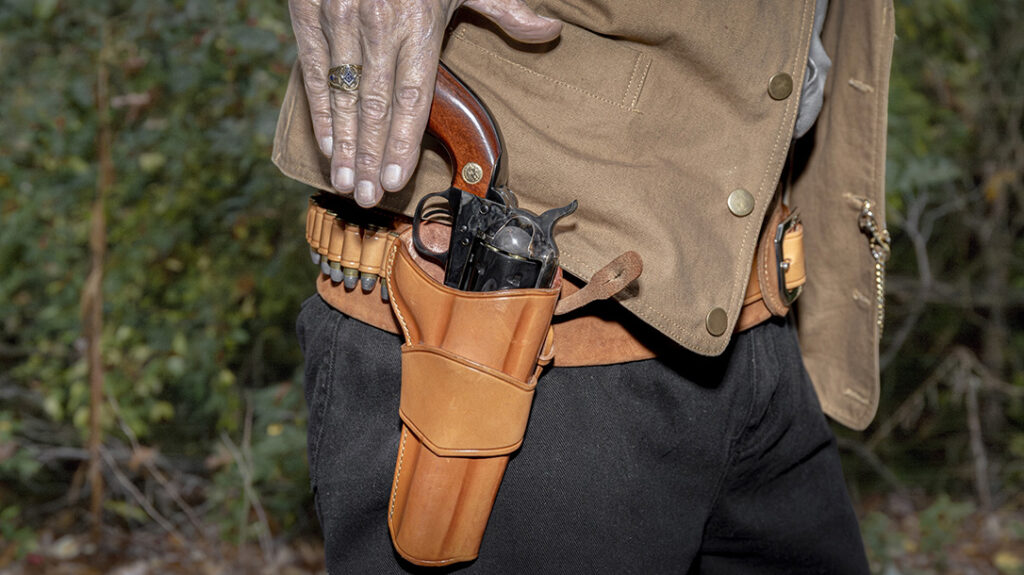
Cowboy Up
Before I did some paper-punching at a square range, I wanted to take the Cimarron Model P to the last cowboy shoot of the 2023 season, put on by the Scarlet Mask Vigilance Society. For a leather rig I decided on the very “John Wayne-looking” Model 1880 cartridge belt and holster from Galco. Made of roughout leather in the style of a money belt, the Model 1880 has natural color leather billets and 30 cartridge loops. Its square cornered brass buckle is nickel plated. The holster rides high on the belt and is styled like a single Mexican loop, but with no exposed skirt in the back. Mine is hand boned for a 4.75-inch SAA revolver and has a slit leather hammer thong. This is a very functional and attractive rig.
My character for this year-end Western action-shooting event was to be Charles “Fred” Lambert; a late 19th early 20th Century lawman from Cimarron, New Mexico Territory. Fred had a long career in law enforcement and was at various times a town marshal, deputy sheriff, constable, game warden, and New Mexico Mounted Patrolman. There is a display dedicated to Fred Lambert at the museum that is part of the NRA Whittington Center, near Raton, New Mexico. In the display case is a Colt SAA in .38 WCF with a 5.5-inch barrel that Fred used as a Mounted Policeman. For the shooting match, I wore a replica of a badge that belonged to Fred Lambert.
Orange Leaves and Hot Lead
Despite some damp, chilly conditions, I was encouraged to see a good attendance at the cowboy shoot. At least 45-49 folks were at the “Cowboy Town” range run by the Scarlet Mask Vigilance Society. There were four interesting shooting stages based on scenes in the movie “The Outlaw Josey Wales.” We assembled into two large “posses,” shot two stages, broke for a potluck lunch, then shot the last two stages.
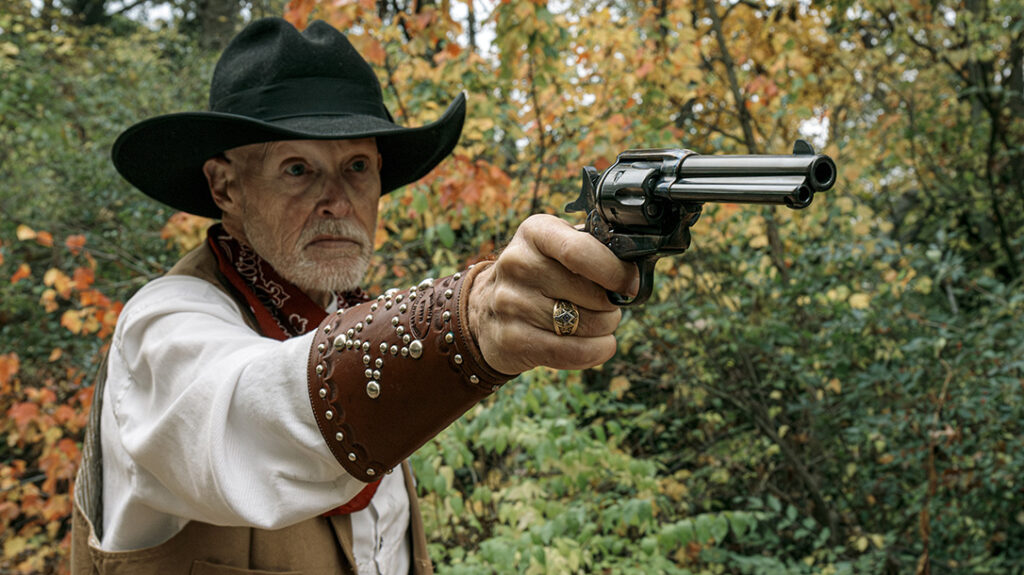
At the end, there was a “mano-a-mano” shootout using a steel plate tree. I had fired a few sighting shots just before the match with the Cimarron Model P using the Black Hills and handloaded ammo before the match started, so I had a good idea where it was hitting. The Model P and the two test loads were accurate and reliable in rapid-fire shooting. Cimarron’s sixgun ran fine through the event, and I ended up on the overall list of competitors in 5th place.
More Rounds Downrange
Next, it was time for some square range work. I was interested to see what kind of velocities I’d get from the .38-40 loads I had. Setting up my Oehler Model 35P chronograph I obtained average velocity figures for each of the test loads. You can see the data in the accompanying performance table. For an accuracy potential evaluation, I shot the Model P from a distance of 15 yards at oval-shaped bullseye targets. Shooting was done using a sandbag rest, from the bench. The front sight is wider than on the old SAA, and the rear sight is a square notch instead of being V or U-shaped like on older Model P’s; this gave a good sight picture. I noted the sights were well regulated regarding point of aim/point of impact, and the trigger pull was pretty decent too.
I wasn’t surprised that I got some darn good five-shot groups. The best measured 1.02 inches using the Black Hills cowboy cartridges. Hanna’s handload was second with a 1.08” cluster. Group averages for three 5-shot groups were between 1.56 and 2.09 inches. The rest of the group information is in the performance table. Empty brass was extracted with no problem. There was no set-back of fired brass due to the bottle-necked cartridge case. The Cimarron Model P is a winner!
For more info, visit cimarron-firearms.com and galcogunleather.com.
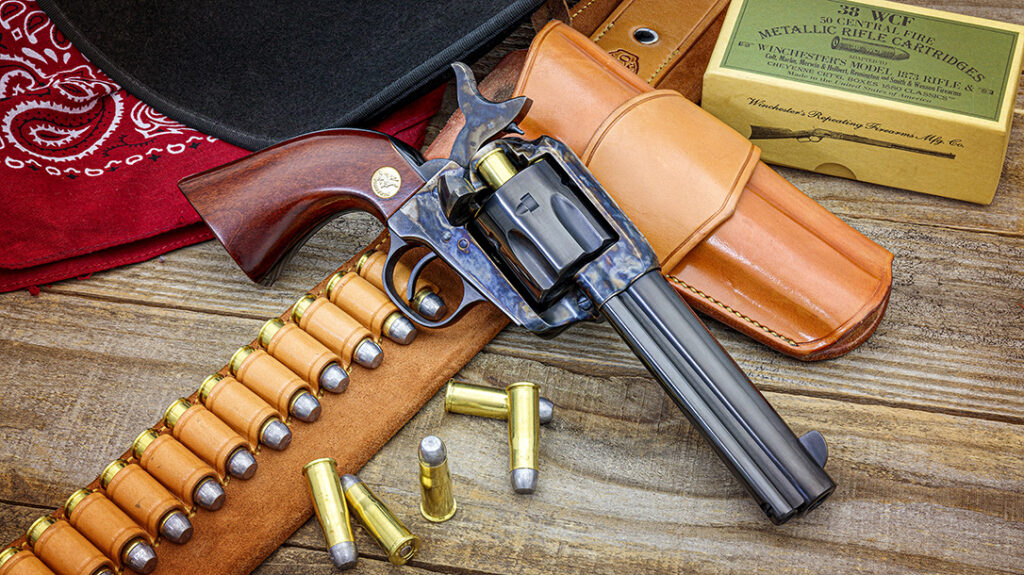
Cimarron Model P Specifications
- MECHANISM: Traditional single action revolver
- CALIBER: .38 WCF (.38-40)
- CAPACITY: 6 cartridges
- BARREL: 4.75 in.
- OA LENGTH: 10.25 in.
- EMPTY WEIGHT: 41 oz.
- SIGHTS: Fixed square notch rear, rounded blade front
- FINISH: Blue/color case-hardened
- STOCKS: One-piece walnut with gold Cimarron medallions
- MSRP: $690.95
Cimarron Model P .38 WCF Performance
| Cartridge | Average Velocity | Best Group | Average Group |
| Black Hills Cowboy Cartridges 180 gr. 180-grain FPL | 763 | 1.02” | 1.61” |
| Buffalo Bore Heavy Load 180-grain Hard Cast LFP | 972 | 1.55” | 2.09” |
| Handloaded Cartridge 180-grain LFP w/ 6.0 gr. Red Dot Powder | 759 | 1.08” | 1.56” |
| Winchester Super-X Hunting 180-grain JSP | 779 | 1.19” | 1.91” |
Didn’t find what you were looking for?
Read the full article here





